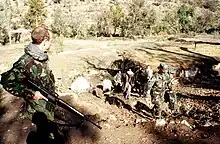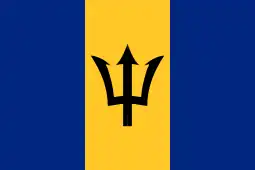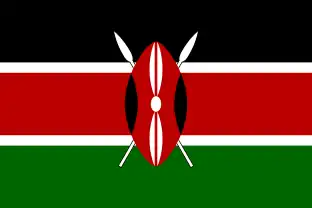58 pattern webbing
1958 Pattern Web Equipment[1][2] was a modular personal equipment system issued to the British Armed Forces from 1959[1] up until the mid 90s. It replaced the 1937 Pattern Web Equipment that had served the UK's Armed Forces through the Second World War and the first decade of the Cold War and also the 1944 pattern Webbing which was used in jungle conditions starting from the mid-1960s.


.jpg.webp)
It was in turn gradually replaced in the 1990s by 90 and 95 Pattern Personal Load Carrying Equipment (PLCE),[3][4] though usage in Ministry of Defence-sponsored Community and Combined Cadet Forces persisted into the 2000s.[5] Although replaced, the belt in particular seems to survive as an unofficial form of dress (replacing the general issue Working Belt) by older soldiers when worn with Combat Soldier 95 clothing.
Components

A standard set of 1958 Pattern webbing as issued to most British personnel consisted of a belt, a yoke that supported the attachment of a shovel or pick, two ammunition pouches to carry magazines for the L1A1 rifle, L2A3 submachine gun, or L4A1-A9 machine gun, linked 7.62mm ammunition for the L7A1/A2 machine gun, and/or L2A1/A2 and other grenades (with the left-hand pouch having provision for carrying a sheathed bayonet and the right-hand pouch having an external pocket to the rear for the ENERGA rifle grenade adapter), a water bottle pouch (also able to be fitted with a mug while containing the waterbottle), a pair of rear "kidney" pouches (for the storage of spare underwear and socks, washing and shaving kit, boot cleaning items, twenty-four-hour rations, and any other items that the user may need to have secured), a poncho roll or "cape carrier", and a large pack.[3][6]
The standard webbing could be altered to take additional pieces of needed equipment, an example of which is the large pack having provision for externally carrying a blanket or sleeping bag and, if not worn, the Mark IV helmet.[7]
There were a number of ancillary pouches and fittings available for soldiers carrying other armament or conducting certain roles, e.g. a holster for the L9A1 and other pistols,[8] a compass pouch,[9] and a binocular case.[6]
All components of the webbing equipment were made from pre-shrunk canvas webbing that was dyed in Standard Camouflage Colour (SCC) 15 Green and could be cleaned through conventional methods (as opposed to the 1908 and 1937 web equipments that used Blanco for both colouration and cleaning; fitting instructions for the 1958 equipment specifically forbade scrubbing or Blancoing of the equipment as well as any attempt to remove the finish on metal parts[10]); the metal fittings were made from anodised dark green aluminium, again requiring less cleaning compared to the brass fittings of earlier web equipments (though said fittings were supposed to be allowed to grow dull for fieldcraft purposes anyway).[3][6]
In its standard configuration, each of the belt-mounted components was secured to the belt by a pair of double hooks (one double hook only in the case of the compass pouch) at the rear, hooked over the belt above and below, with the ends of the hooks further retained in canvas pockets on the inside face of the belt.[11] However, some sets of webbing, particularly where used by special forces, were fitted or modified with a canvas loop on the pouches into which the belt was threaded. This method of attachment allowed the pouch to be moved around the belt for the comfort of the user, for example when sitting for long periods. Some sets were also modified with quick-release buckles on the belt, pouches, or both, and could also feature pouches taken from other load-bearing systems.[12][13] Most personnel used their webbing as issued, however.
Several of the individual components evolved over the lifetime of the 1958 Pattern system. There were three iterations of the standard (SLR) ammunition pouches, and two of the water-bottle pouch, poncho roll and yoke.
Usage
The equipment was worn in a series of combinations. Weapon Training or Skeleton Order consisted of the belt, the yoke, the two ammunition pouches, and the water bottle pouch,[4] becoming Light Fighting Order (LFO) with the addition of the rear pouches and, if desired, the cape carrier.[3] Combat Equipment Fighting Order (CEFO) was the term used for the full webbing equipment (comprising the LFO and cape carrier with the addition of entrenching tools),[10][3] and once the large pack was attached it became Combat Equipment Marching Order (CEMO).[7]
A further informal order, effectively amounting to Skeleton Order without the yoke and with a minimal number of pouches, was often used by soldiers serving in the Aden Emergency and later Operation Banner to aid disembarkation from vehicles;[14] soldiers who were tasked with searching vehicles at security checkpoints often carried a pistol in lieu of a rifle and thus went even further in reducing their webbing, only wearing the belt and the pistol's holster.[15]
Over the course of its service, there were a number of developments and modifications. When the system was originally designed, little scope was given to Nuclear, Biological, and Chemical (NBC) warfare and when this was addressed, the system gained a respirator haversack to house the then issue S6 NBC Respirator.
Variants
72 Pattern webbing
61 pattern webbing
- 61 pattern webbing, A South African copy, used by Rhodesian Forces as 69 pattern.
- 1970 pattern webbing, South African equivalent
- 69 pattern webbing, Rhodesian webbing
UTV webbing
- UTV webbing, East German equivalent made of nylon/rain camo
Users

.jpg.webp)
 Barbados: Primarily used by the Defence Force, also used by the Royal Barbados Police Force contingent of the Caribbean Peace Force[16]
Barbados: Primarily used by the Defence Force, also used by the Royal Barbados Police Force contingent of the Caribbean Peace Force[16] Iraq: Used during Ba'athist rule, primarily imported from Pakistan[17][18]
Iraq: Used during Ba'athist rule, primarily imported from Pakistan[17][18] Ireland: Imported from Great Britain;[19] replaced by PLCE webbing by the early 2000s[20]
Ireland: Imported from Great Britain;[19] replaced by PLCE webbing by the early 2000s[20] Jamaica[16]
Jamaica[16] Kenya[21]
Kenya[21] Kuwait[17]
Kuwait[17] Nigeria[22]
Nigeria[22] Pakistan: Domestically produced[23][18]
Pakistan: Domestically produced[23][18] Sierra Leone[24]
Sierra Leone[24] United Kingdom: British Armed Forces (replaced by PLCE in the 1990s)[1][2][3][4][25] and MOD-sponsored cadet forces (also replaced by PLCE, albeit at a slower rate than the Armed Forces)[5]
United Kingdom: British Armed Forces (replaced by PLCE in the 1990s)[1][2][3][4][25] and MOD-sponsored cadet forces (also replaced by PLCE, albeit at a slower rate than the Armed Forces)[5]
References
- Instructions for Assembling Web Equipment Pattern 1958. The Infantry Directorate, The War Office. 15 October 1959.
- Army Code No. 14715, Web Equipment Pattern 1958, Instructions for Assembly. Ministry of Defence (Army), Directorate of Stores & Clothing Development. September 1965.
- "Webbing, 1958 pattern (Light Fighting Order)". Imperial War Museum. Retrieved 23 April 2022.
- "Webbing, 1958 pattern (Skeleton Order)". Imperial War Museum. Retrieved 23 April 2022.
- "Chapter 1. — Turnout, Section 4. — Preparation and Packing of the 58 Pattern Equipment". Army Code No. 71462, The Cadet Training Manual Volume I 1990 (Reprinted incorporating Amendments 1 – 6, June 2001). Ministry of Defence (United Kingdom). June 2001.
- M. Wright and Sons Ltd. (21 October 1988). Webbing Equipment Manufacturers.
- Army Code No. 14715, Web Equipment Pattern 1958, Instructions for Assembly. Ministry of Defence (Army), Directorate of Stores & Clothing Development. September 1965. pp. 12–14.
- "Holster, Pistol, Webbing, 1958 pattern (for Browning HP-35): British Army". Imperial War Museum. Retrieved 23 April 2022.
- "Webbing, Artkis Chest Rig: British". Imperial War Museum. Retrieved 23 April 2022.
A canvas webbing 1958 pattern equipment compass pouch is attached.
- Army Code No. 14715, Web Equipment Pattern 1958, Instructions for Assembly. Ministry of Defence (Army), Directorate of Stores & Clothing Development. September 1965. p. 15.
- "Pouch, Ammunition, Webbing, 1958 pattern (right): British Army". Imperial War Museum. Retrieved 23 April 2022.
- "Modified heavy-drop platform belt, 1970 (c)". National Army Museum. Retrieved 23 April 2022.
- "Tailored 58 Pattern Webbing as worn by Sgt Bob Hilton, 2 PARA, 2002 from the Airborne Assault Museum, Duxford". ParaData. Retrieved 15 August 2023.
- Ripley, Tim (28 January 1993). Security Forces in Northern Ireland 1969–92. Osprey Publishing. pp. 51, 59. ISBN 9781855322783.
- Ripley, Tim (28 January 1993). Security Forces in Northern Ireland 1969–92. Osprey Publishing. p. 53. ISBN 9781855322783.
- Lee E Russell (28 March 1985). Grenada 1983. Osprey Publishing. p. 46. ISBN 9780850455830.
- Gordon L. Rottman (27 May 1993). Armies of the Gulf War. Osprey Publishing. p. 53. ISBN 9781855322776.
- McNab, Chris (20 Jan 2022). Armies of the Iran–Iraq War 1980–88. Osprey Publishing. pp. 38, 44, 54. ISBN 9781472845573.
- Ripley, Tim (28 January 1993). Security Forces in Northern Ireland 1969–92. Osprey Publishing. p. 61. ISBN 9781855322783.
- MacCarron, Donal (22 October 2004). The Irish Defence Forces since 1922. Osprey Publishing. p. 47. ISBN 9781841767420.
- "NATURAL FIRE 10 - FTX - US ARMY AFRICA - 091018M3149V011". flickr.com. U.S. Army Southern European Task Force, Africa. 18 October 2009. Retrieved 24 April 2022.
- Jowett, Philip (22 September 2016). Modern African Wars (5): The Nigerian-Biafran War 1967–70. Osprey Publishing. ISBN 9781472816092.
- Gordon L. Rottman (27 May 1993). Armies of the Gulf War. Osprey Publishing. pp. 53, 59. ISBN 9781855322776.
- "ACOTA Training in Sierra Leone". flickr.com. U.S. Army Southern European Task Force, Africa. 21 September 2011. Retrieved 24 April 2022.
- "British Army: Vehicles and Equipment" (PDF). Ministry of Defence. Archived from the original (PDF) on 19 November 2010. Retrieved 11 April 2019.